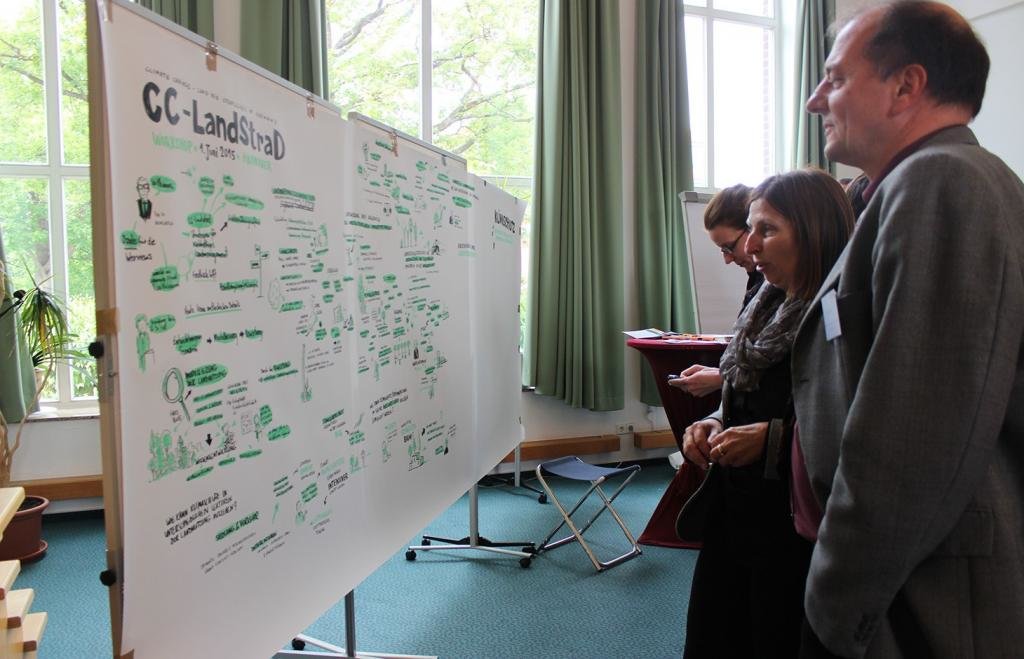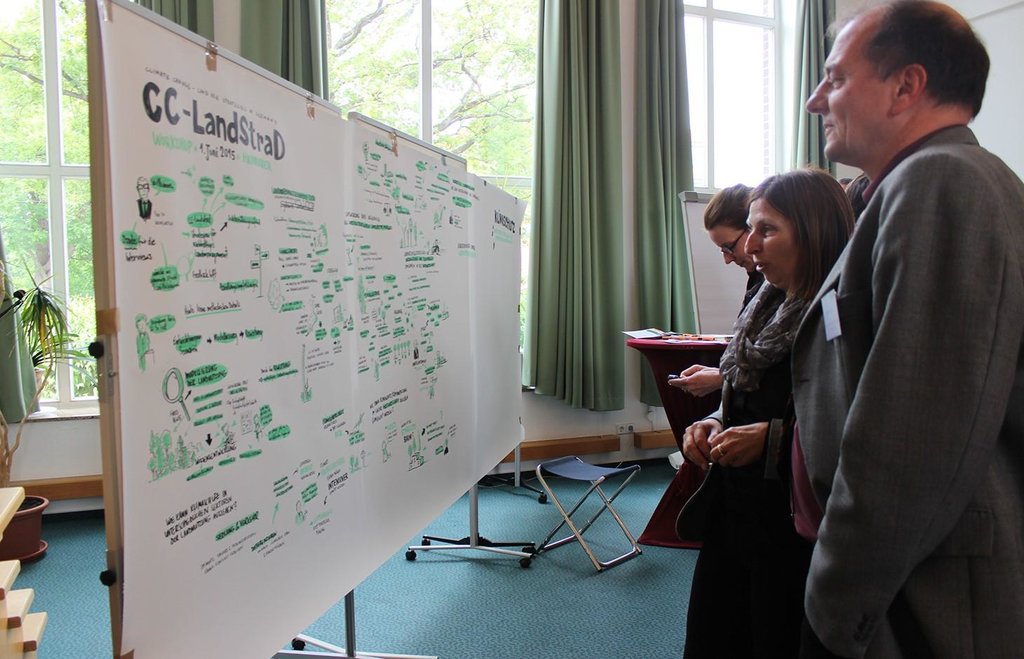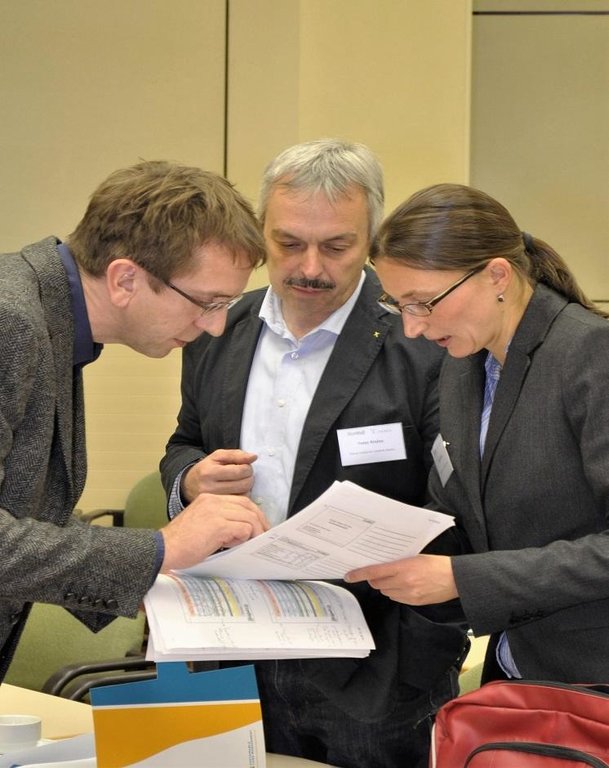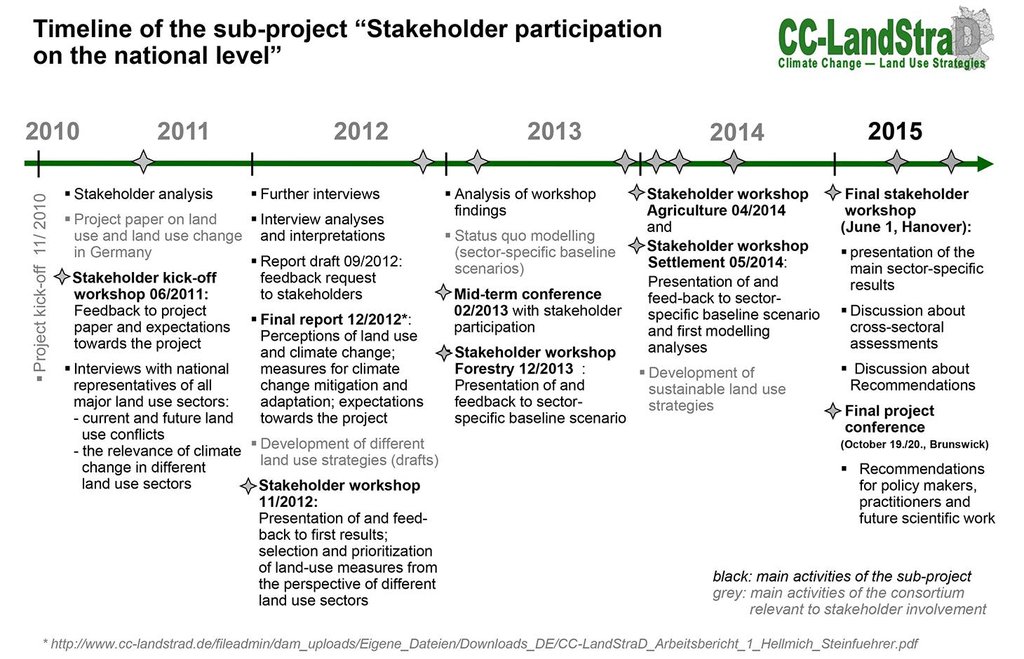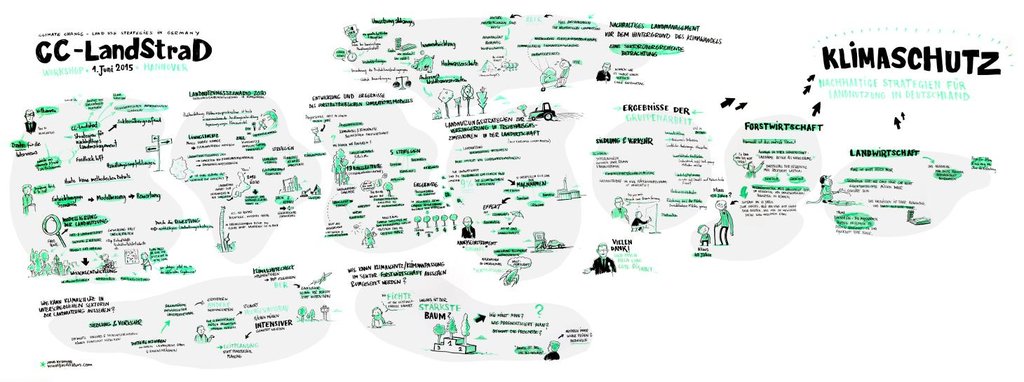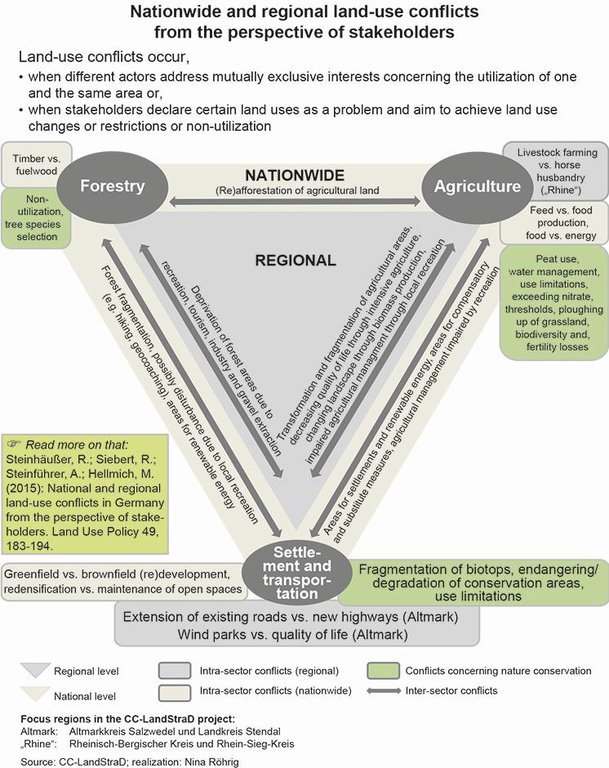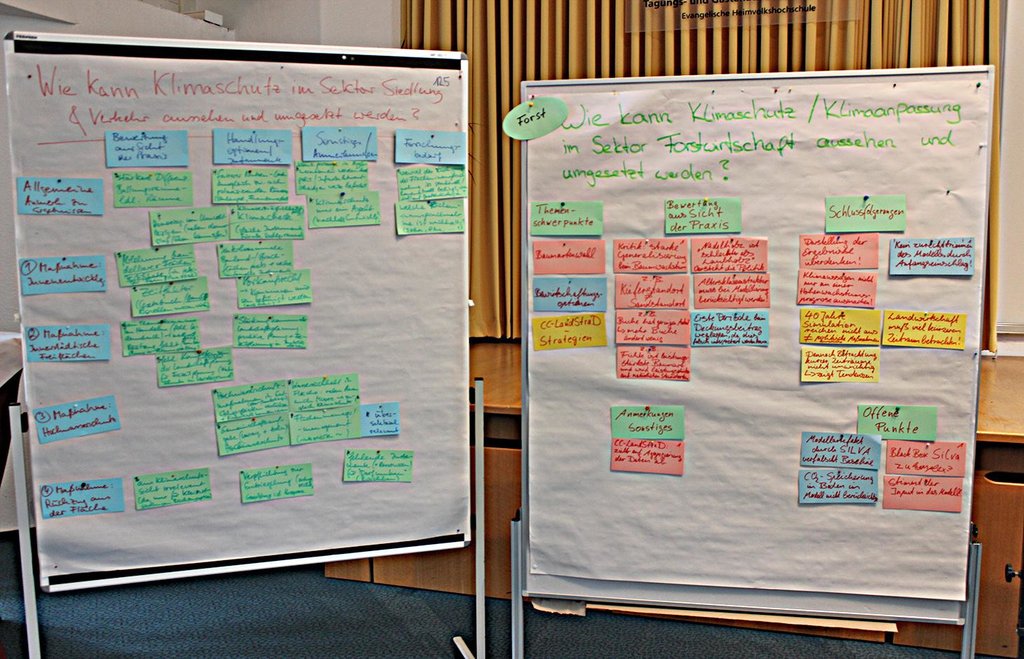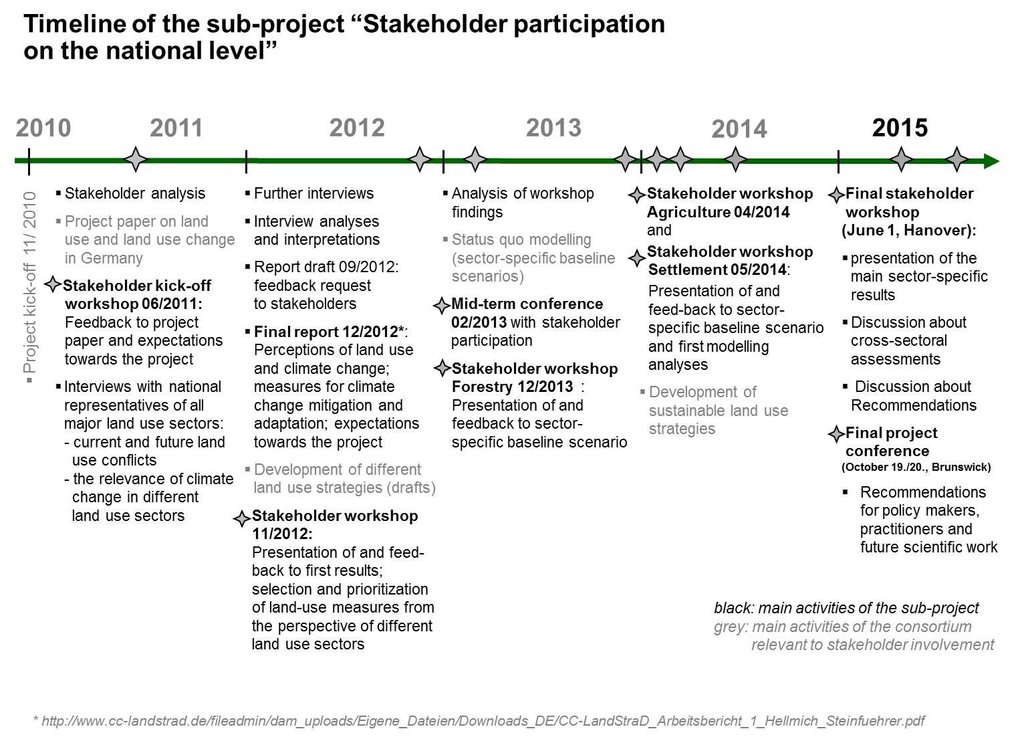Open dialogue platform on sustainable land management [Allemagne]
- Création :
- Mise à jour :
- Compilateur : Johanna Fick
- Rédacteur : –
- Examinateurs : Fabian Ottiger, Deborah Niggli
approaches_2605 - Allemagne
Voir les sections
Développer tout Réduire tout1. Informations générales
1.2 Coordonnées des personnes-ressources et des institutions impliquées dans l'évaluation et la documentation de l'Approche
Nom du projet qui a facilité la documentation/ l'évaluation de l'Approche (si pertinent)
Book project: Making sense of research for sustainable land management (GLUES)Nom du ou des institutions qui ont facilité la documentation/ l'évaluation de l'Approche (si pertinent)
CC-LandStraD - AllemagneNom du ou des institutions qui ont facilité la documentation/ l'évaluation de l'Approche (si pertinent)
Thünen Institute (Thünen Institute) - Allemagne1.3 Conditions relatives à l'utilisation par WOCAT des données documentées
Quand les données ont-elles été compilées (sur le terrain)?
04/08/2015
Le compilateur et la(les) personne(s) ressource(s) acceptent les conditions relatives à l'utilisation par WOCAT des données documentées:
Oui
1.4 Références au(x) questionnaire(s) sur les Technologies de GDT
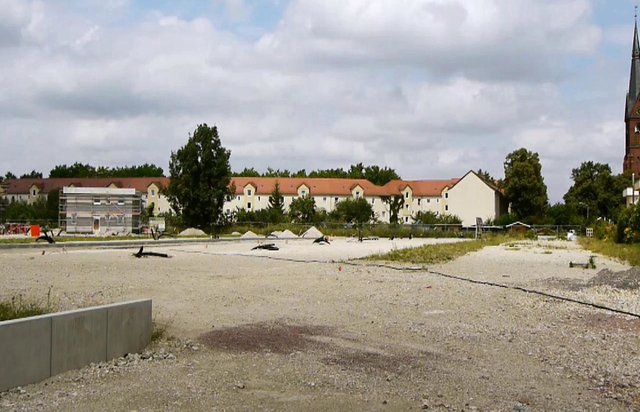
High-quality inner urban development [Allemagne]
A scenario simulation of land use change where high-quality inner urban development is promoted, including the rehabilitation of brownfields, reuse of vacant lots, use of gaps between buildings and the improvement of existing structures.
- Compilateur : Johanna Fick
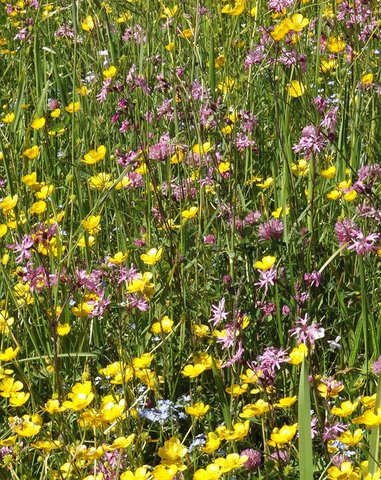
Grassland preservation [Allemagne]
Grassland preservation by the avoidance of ploughing up of grassland and its transformation into cropland
- Compilateur : Johanna Fick
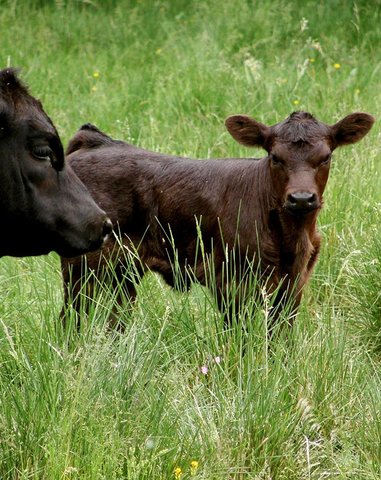
Adapted management of organic soils [Allemagne]
Re-wetting of organic soils and following adapted management suitable for wet conditions like extensive grazing land or paludiculture.
- Compilateur : Johanna Fick
2. Description de l'Approche de GDT
2.1 Courte description de l'Approche
Establishing a dialogue platform on sustainable land management which is open to all stakeholders
2.2 Description détaillée de l'Approche
Description détaillée de l'Approche:
Aims / objectives: The cross-sectoral stakeholder discussion platform on SLM aims to involve all relevant stakeholders in a specific SLM topic, or within a particular region in a dialogue process leading to better understanding and to a sustainable solution where there are multifunctional claims on land. The platform operates in Germany.
Examples of possible topics are to work out, together, the main land use conflicts in a region (e.g. reduced land for agriculture because of increased settlement pressures) and then to jointly develop sustainable solutions for the land use conflicts addressed. The platform was established by a non-governmental group within a transdisciplinary research project (CC-LandStraD) financed by the Federal Ministry of Education and Research (BMBF) in Germany. The transdisciplinary research approach is carried out in cooperation with regional authorities.
The platform was established by a non-governmental group of researchers of a transdisciplinary research project financed by the Federal ministery of education and research in cooperation with regional authorities (transdisciplinary approach).
Methods: The platform provides a forum to discuss specific topics cross-sectorally (for example, agriculture, forestry, settlement and transportation, and nature conservation) and for multi-stakeholders (for example land users, advisors, specialists, planners, and decision makers). To establish this platform, a neutral setting and external moderation is helpful. Methods which can be used at the platform include separate sectoral and cross-sectoral workshops, excursions, information events and newsletters. Furthermore, there are simulations of different scenarios on current land use and on land use development and distribution, and at the same time there is cross-sectorial and transdisciplinary learning. This platform is not a single event, but an on-going process. Access barriers, for example an entrance fee, should not exist.
Stages of implementation: To initiate a platform, the most relevant aspects of a region/community and all related stakeholders have to be established through a stakeholder analysis. Interviews and surveys are employed to indicate who the relevant stakeholders are. During interviews the potential stakeholders are asked who they work with regarding land use. Further stages then focus on the most relevant aspects. These may be current land use conflicts like losses of agricultural land because of settlement and transportation infrastructure. Alternatively they can be conflicts regarding production of goods either for food, feed or energy purposes, or disputes concerning intensive or extensive agriculture, with the consequent implications on nature and environment conservation. Depending on which conflict is addressed, the relevant stakeholder and the process which is needed (e.g. sectoral talks, cross-sectoral talks, focus groups) can be identified. To identify the most relevant land use conflicts stakeholder are asked to rank the most relevant land use conflicts that affect them.
Role of stakeholders: Each stakeholder is welcomed and has the opportunity to state his/her opinion in an open-result discussion. The cross-sectoral learning process is an important aspect of this approach. In the case presented case there is interaction between stakeholders from agriculture, forestry and settlement/transport as well as nature conservation, regional and environmental planning and governmental institutions. The stakeholders were asked for the main land use conflicts in their work, relevant measures to resolve the situation, and their design, then discussed the scenario assumption, and selected results and possible implications.
2.3 Photos de l'approche
2.5 Pays/ région/ lieux où l'Approche a été appliquée
Pays:
Allemagne
Région/ Etat/ Province:
Germany, Saxony-Anhalt
Autres spécifications du lieu :
Altmarkkreis Salzwedel and district Stendal (total area of region: 4744 km²)
2.6 Dates de début et de fin de l'Approche
Indiquez l'année de démarrage:
2010
Date (année) de fin de l'Approche (si l'Approche n'est plus appliquée):
2015
2.7 Type d'Approche
- fondé sur un projet/ programme
2.8 Principaux objectifs de l'Approche
The Approach focused mainly on SLM with other activities (different interests on SLM in dialogue, cross-sectoral and with all related interest groups)
A cross-sectoral stakeholder discussion platform on SLM aims at involving all relevant stakeholders around a specific SLM topic, or within a particular region in a dialogue process leading to better understanding and improved, sustainable, solutions. In a “business as usual” situation, generally no cross sectoral talks or interaction take place. With such a platform however, more knowledge and direct talks between stakeholders from different sectors provide the opportunity for solutions.
The SLM Approach addressed the following problems: There are different and competing demands on land which can conflict with the conventional uses for agriculture and forestry. These include biomass for energy, new settlements and transportation infrastructure. Space is also needed for tourism and leisure facilities; and also for measures of environmental protection. All of these can have an impact on the area available for, and the management of, farmland and forests. And there are competing economic interests in land management. As land is a limited resource, problems between different stakeholders are inevitable and becoming more frequent.
2.9 Conditions favorisant ou entravant la mise en œuvre de la(des) Technologie(s) appliquée(s) sous l'Approche
normes et valeurs sociales/ culturelles/ religieuses
- entrave
All stakeholder have different backgrounds and different levels of knowledge and interests. Sometimes the relevant stakeholders don't know each other.
Treatment through the SLM Approach: A neutral setting, so that no stakeholder has a(n) (dis)advantage and an external
moderation which is accepted by all involved stakeholders, and professional input by experts (e.g. from research institutions) so that a joint learning process starts. Here it is essential to provide a good atmosphere and a common understanding of the key questions.
disponibilité/ accès aux ressources et services financiers
- entrave
Different stakeholders have different resources to contribute to this platform (e.g., time, finance, knowledge, equipment like beamer, microfons etc.).
Treatment through the SLM Approach: Trying to keep the barriers as low as possible and equal for each and every stakeholder (e.g. no entrance fee, public invitations in advance, central meeting location, meeting at a suitable time for the stakeholders).
cadre juridique (régime foncier, droits d'utilisation des terres et de l'eau)
- favorise
The existing land ownership, land use rights / water rights moderately helped the approach implementation: . The land ownership, land use rights/water rights are quite clear in Germany. So it is easy to identify the relevant stakeholders on SLM. But these are only a few target groups. There are much more which are relevant to get a good platform on SLM e.g. nature conservation groups, tourism associations.
charge de travail, disponibilité de la main-d'œuvre
- entrave
To implement and run a dialogue platform it takes time and professional skills and resources (e.g. high motivation and high frustration tolerance, moderation and motivation methods, knowledge about group dynamics).
Treatment through the SLM Approach: Be aware of this before the dialogue platform is set-up (such a process is not a one-off short-term, activity: it’s better thought of as medium-long term process).
autre
- entrave
1. Stakeholders have different levels of knowledge and professionality
2. Previous conflicts (some known; some hidden) and other areas of controversy sometimes come to light during discussions.
Treatment through the SLM Approach: 1. It is necessary to make information accessible by moderation and to create common understanding (e.g. sometimes the same term exists in agriculture and forestry but has a different meaning).
2. Be sensitive to nonverbal communication or conflict topics and be prepared to deal with such issues even if not communicated verbally.
3. Participation et rôles des parties prenantes impliquées dans l'Approche
3.1 Parties prenantes impliquées dans l'Approche et rôles
- exploitants locaux des terres / communautés locales
Farmers, forest owners, counties, municipalities, associations on agriculture, forestry or nature conservation
Participating groups with less financial resources received travel grants
- Spécialistes de la GDT/ conseillers agricoles
- gouvernement national (planificateurs, décideurs)
Regional planners, planners on settlement and transport
On federal and county level
Remark: should include: agricultural, forestal, settlement and transport sector as well nature conservation. It is essentiell to deal with all of these people, that is the important part of this approach
Si plusieurs parties prenantes sont impliquées, indiquez l'organisme chef de file ou l'institution responsable:
We initiated this approach by a non-govenmental group of reseachers in cooperation with regional authorities. But this approach is not related to one body. Either national non-government or government or private sector or local government or local community/a group of land user can start the approach.
3.2 Participation des exploitants locaux des terres/ communautés locales aux différentes phases de l'Approche
| Participation des exploitants locaux des terres/ communautés locales | Spécifiez qui était impliqué et décrivez les activités | |
|---|---|---|
| initiation/ motivation | interactive | scientists working with transdisciplinary processes |
| planification | interactive | scientists on transdisciplinary processes and disciplinary scientists on SLM |
| mise en œuvre | passive | all involved stakeholders mentioned above = passive; scientists = interactive |
| suivi/ évaluation | passive | all involved stakeholders mentioned above, scientists |
| Research | interactive | all involved stakeholders mentioned above and all scientists |
3.3 Diagramme/ organigramme (si disponible)
Description:
Time sheet stakeholder participation on national level.
The ‘sub-project' started in the first year with an overview workshop on current and future land use and climate change, followed by face-to-face interviews. The second year focused on the process to identify the most relevant measures for climate mitigation of each sector (agriculture, forestry, settlement and transportation, and nature conservation). The last three years were used to discuss preliminary results and to evaluate the results from the stakeholder perspectives.
Auteur:
Meike Hellmich, Annett Steinführer (Thünen-Institut Braunschweig)
3.4 Prises de décision pour la sélection de la Technologie/ des Technologies
Les décisions concernant la sélection de la(des) Technologie(s) ont elles été prises:
- multi-stakeholder dialogue process
Expliquez:
Land users supported by SLM specialists e.g. an extensive management of grassland
SLM specialists with consultation of land users: practical test phase of new technology or innovative practise
by politicians / leaders (e.g. decisions regarding societal aims like environment protection)
Decisions on the method of implementing the SLM Technology were made by no decisions. No decisions have been made yet.
4. Soutien technique, renforcement des capacités et gestion des connaissances
4.1 Renforcement des capacités/ formation
Une formation a-t-elle été dispensée aux exploitants des terres/ autres parties prenantes?
Oui
Spécifiez qui a été formé:
- exploitants des terres
- personnels/ conseillers de terrain
- involved people
Thèmes abordés:
The activities focused on each level/stage (measures, scenarios, results and implication) to provide knowledge to and with all participants in order to focus on the meeting's objectives and to raise awareness (why are we doing this? why is it important to be here? why should we talk about this topic?).
4.2 Service de conseils
Les exploitants des terres ont-ils accès à un service de conseils?
Oui
Décrivez/ commentez:
Advisory service is quite adequate to ensure the continuation of land conservation activities; The approach raised awareness and brought people together who normally don’t discuss topics with each other.
4.3 Renforcement des institutions (développement organisationnel)
Des institutions ont elles été mises en place ou renforcées par le biais de l'Approche?
- oui, un peu
Spécifiez à quel(s) niveau(x), ces institutions ont été renforcées ou mises en place:
- local
Décrivez l'institution, ses rôles et responsabilités, ses membres, etc.
This method can support local institutions via the input and mutual discussions of regional associations and groups. However, certain groups may mutually exclude each other.
4.4 Suivi et évaluation
Le suivi et l'évaluation font ils partie de l'Approche? :
Oui
Commentaires:
socio-cultural aspects were monitored by project staff through observations; indicators: Interviews by scientists at the project end regarding cross-sectoral and transdisciplinary approach
There were no changes in the Approach as a result of monitoring and evaluation
There were no changes in the Technology as a result of monitoring and evaluation
4.5 Recherche
La recherche a-t-elle fait partie intégrante de l’Approche?
Oui
Spécifiez les thèmes:
- sociologie
- économie/ marketing
- écologie
Donnez plus de détails et indiquez qui a mené ces recherches:
Simulation of land use development in Germany was undertaken, including simulation of agricultural economics, forest economics and simulation of settlement and transport areas development, of GHG emissions of land use, and a population survey on perceptions of landscapes
Research was carried out on station
5. Financement et soutien matériel externe
5.1 Budget annuel de la composante GDT de l'Approche
Si le budget annuel précis n'est pas connu, indiquez une fourchette:
- < 2 000
Commentez (par ex. principales sources de financement/ principaux bailleurs de fonds):
Approach costs were met by the following donors: government: 95.0%; local government (district, county, municipality, village etc): 5.0%
5.2 Soutiens financiers/ matériels fournis aux exploitants des terres
Les exploitants des terres ont-ils reçu un soutien financier/ matériel pour la mise en œuvre de la Technologie/ des Technologies?
Non
5.3 Subventions pour des intrants spécifiques (incluant la main d'œuvre)
- aucun
Commentaires:
Time which was needed to take part in the dialogue platform other inputs not relevant
5.4 Crédits
Des crédits ont-ils été alloués à travers l'Approche pour les activités de GDT?
Non
6. Analyses d'impact et conclusions
6.1 Impacts de l'Approche
Est-ce que l'Approche a aidé les exploitants des terres à mettre en œuvre et entretenir les Technologies de GDT?
- Non
- Oui, un peu
- Oui, modérément
- Oui, beaucoup
The complex topic land use and climate change (with focus on climate change mitigation) was analysed and presented to the involved stakeholders. The interaction during cross-sectoral workshops gave a more detailed picture on SLM compared with workshops with a sectoral focus. The better knowledge base helps to improve SLM.
Est-ce que l'Approche a autonomisé les groupes socialement et économiquement défavorisés?
- Non
- Oui, un peu
- Oui, modérément
- Oui, beaucoup
Not in the focus
Did other land users / projects adopt the Approach?
- Non
- Oui, un peu
- Oui, modérément
- Oui, beaucoup
The approach is also used in regional development processes sometimes.
Did the Approach lead to improved livelihoods / human well-being?
- Non
- Oui, un peu
- Oui, modérément
- Oui, beaucoup
; the awareness of intensive land use in Germany and in our focus regions was raised, especially regarding the interaction between agricultural land use and (for example) water quality because of intensive agriculture including the application of fertilizers, pesticides or herbicides. Often these chemical inputs cannot absorbed by plants or soil so the unused resources concentrate in groundwater and thus needs to purified before drinking. Land use improvements can be achieved by agreeing the division between settlement, transport and land for agricultural production - and also for sustainable land use to reduce GHG emissions in agriculture and forestry.
Did the Approach help to alleviate poverty?
- Non
- Oui, un peu
- Oui, modérément
- Oui, beaucoup
6.2 Principale motivation des exploitants des terres pour mettre en œuvre la GDT
- affiliation à un mouvement/ projet/ groupe/ réseaux
in this approach all land using sectors were involved for the first time
6.3 Durabilité des activités de l'Approche
Les exploitants des terres peuvent-ils poursuivre ce qui a été mis en œuvre par le biais de l'Approche (sans soutien extérieur)?
- oui
Si oui, décrivez de quelle manière:
This approach is suitable for different levels, for different topics or different stakeholders involved.
6.4 Points forts/ avantages de l'Approche
| Points forts/ avantages/ possibilités du point de vue de l'exploitant des terres |
|---|
| New information, innovative methods and results, current political trends (How to sustain/ enhance this strength: Presentation of new information has to be in a language adequate for the target groups.) |
| Points forts/ avantages/ possibilités du point de vue du compilateur ou d'une autre personne ressource clé |
|---|
| Added value e.g. research can be needed to get new input (How to sustain/ enhance this strength: Clear announcement of added value for different target groups) |
| All relevant stakeholders are involved (How to sustain/ enhance this strength: make sure that all relevant stakeholders are identified during the initial stakeholder analysis.) |
| Cross-sectoral and sectoral meetings by turns, depending on specific aspects of the meeting (How to sustain/ enhance this strength: Problem and solution oriented talks and meetings) |
| Neutral setting and external moderation |
| New information and knowledge by researcher is shared (How to sustain/ enhance this strength: Cooperation with research institution) |
6.5 Faiblesses/ inconvénients de l'Approche et moyens de les surmonter
| Faiblesses/ inconvénients/ risques du point de vue de l’exploitant des terres | Comment peuvent-ils être surmontés? |
|---|---|
| There should be an added value for land user and the added value should be addressed clearly. | e.g. new information provided by researcher must be tailored to the different stakeholders. |
| Faiblesses/ inconvénients/ risques du point de vue du compilateur ou d'une autre personne ressource clé | Comment peuvent-ils être surmontés? |
|---|---|
| It takes time to produce the right working atmosphere and to reach a common language. | Avoid short-term initiatives. |
|
The moderation has to be accepted by all stakeholders. |
7. Références et liens
7.1 Méthodes/ sources d'information
- visites de terrain, enquêtes sur le terrain
- interviews/entretiens avec les exploitants des terres
7.2 Références des publications disponibles
Titre, auteur, année, ISBN:
Steinhäußer, R. et al. (2015) National and regional land-use conflicts in Germany from the perspective of stakeholders
Disponible à partir d'où? Coût?
Land UsePolicy 49, 183-194
Titre, auteur, année, ISBN:
• Lange, A.; Siebert, R.; Barkmann, T. (2016) Incrementality and Regional Bridging: Instruments for Promoting Stakeholder Participation in Land Use Management in Northern Germany.
Disponible à partir d'où? Coût?
Society & Natural Resources , Jul2016, Vol. 29 Issue 7, p868-879, 12p.
Liens et modules
Développer tout Réduire toutLiens

High-quality inner urban development [Allemagne]
A scenario simulation of land use change where high-quality inner urban development is promoted, including the rehabilitation of brownfields, reuse of vacant lots, use of gaps between buildings and the improvement of existing structures.
- Compilateur : Johanna Fick

Grassland preservation [Allemagne]
Grassland preservation by the avoidance of ploughing up of grassland and its transformation into cropland
- Compilateur : Johanna Fick

Adapted management of organic soils [Allemagne]
Re-wetting of organic soils and following adapted management suitable for wet conditions like extensive grazing land or paludiculture.
- Compilateur : Johanna Fick
Modules
Aucun module trouvé



